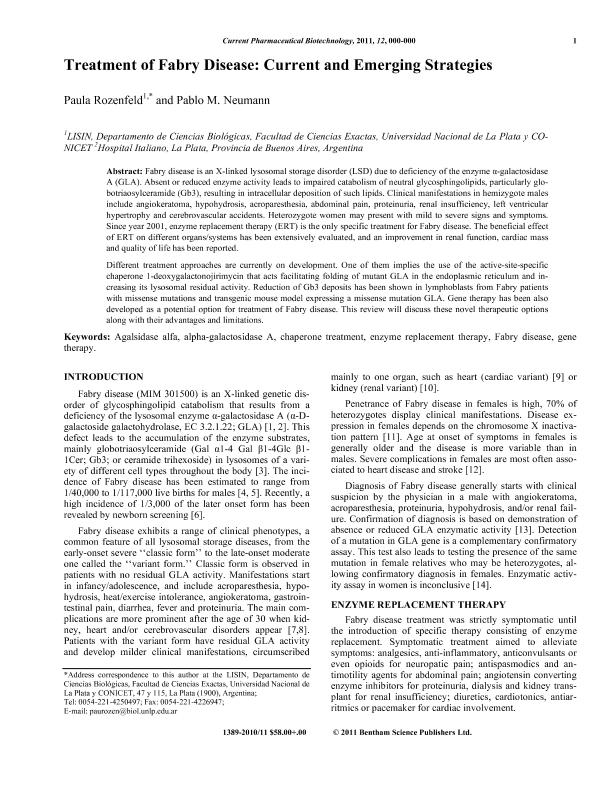Mostrar el registro sencillo del ítem
dc.contributor.author
Rozenfeld, Paula Adriana

dc.contributor.author
Neumann, Pablo M.
dc.date.available
2023-05-04T12:23:29Z
dc.date.issued
2011-01
dc.identifier.citation
Rozenfeld, Paula Adriana; Neumann, Pablo M.; Treatment of fabry disease: Current and emerging strategies; Bentham Science Publishers; Current Pharmaceutical Biotechnology; 12; 6; 1-2011; 916-922
dc.identifier.issn
1389-2010
dc.identifier.uri
http://hdl.handle.net/11336/196240
dc.description.abstract
Fabry disease is an X-linked lysosomal storage disorder (LSD) due to deficiency of the enzyme α-galactosidase A (GLA). Absent or reduced enzyme activity leads to impaired catabolism of neutral glycosphingolipids, particularly globotriaosylceramide (Gb3), resulting in intracellular deposition of such lipids. Clinical manifestations in hemizygote males include angiokeratoma, hypohydrosis, acroparesthesia, abdominal pain, proteinuria, renal insufficiency, left ventricular hypertrophy and cerebrovascular accidents. Heterozygote women may present with mild to severe signs and symptoms. Since year 2001, enzyme replacement therapy (ERT) is the only specific treatment for Fabry disease. The beneficial effect of ERT on different organs/systems has been extensively evaluated, and an improvement in renal function, cardiac mass and quality of life has been reported. Different treatment approaches are currently on development. One of them implies the use of the active-site-specific chaperone 1-deoxygalactonojirimycin that acts facilitating folding of mutant GLA in the endoplasmic reticulum and increasing its lysosomal residual activity. Reduction of Gb3 deposits has been shown in lymphoblasts from Fabry patients with missense mutations and transgenic mouse model expressing a missense mutation GLA. Gene therapy has been also developed as a potential option for treatment of Fabry disease. This review will discuss these novel therapeutic options along with their advantages and limitations.
dc.format
application/pdf
dc.language.iso
eng
dc.publisher
Bentham Science Publishers

dc.rights
info:eu-repo/semantics/openAccess
dc.rights.uri
https://creativecommons.org/licenses/by-nc-sa/2.5/ar/
dc.subject
AGALSIDASE ALFA
dc.subject
ALPHA-GALACTOSIDASE A
dc.subject
CHAPERONE TREATMENT
dc.subject
ENZYME REPLACEMENT THERAPY
dc.subject
FABRY DISEASE
dc.subject
GENE THERAPY
dc.subject.classification
Genética Humana

dc.subject.classification
Medicina Básica

dc.subject.classification
CIENCIAS MÉDICAS Y DE LA SALUD

dc.title
Treatment of fabry disease: Current and emerging strategies
dc.type
info:eu-repo/semantics/article
dc.type
info:ar-repo/semantics/artículo
dc.type
info:eu-repo/semantics/publishedVersion
dc.date.updated
2023-04-10T10:16:17Z
dc.journal.volume
12
dc.journal.number
6
dc.journal.pagination
916-922
dc.journal.pais
Estados Unidos

dc.description.fil
Fil: Rozenfeld, Paula Adriana. Universidad Nacional de La Plata. Facultad de Ciencias Exactas. Departamento de Ciencias Biológicas. Cátedra de Inmunología; Argentina. Consejo Nacional de Investigaciones Científicas y Técnicas. Centro Científico Tecnológico Conicet - La Plata; Argentina
dc.description.fil
Fil: Neumann, Pablo M.. Instituto Universitario del Hospital Italiano de Buenos Aires; Argentina
dc.journal.title
Current Pharmaceutical Biotechnology

dc.relation.alternativeid
info:eu-repo/semantics/altIdentifier/url/https://www.eurekaselect.com/article/18967
dc.relation.alternativeid
info:eu-repo/semantics/altIdentifier/doi/http://dx.doi.org/10.2174/138920111795542705
Archivos asociados
